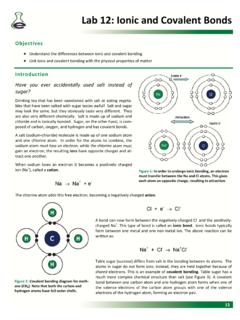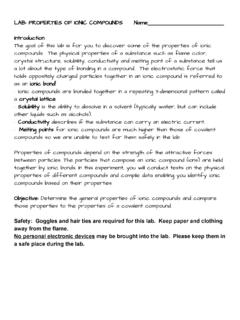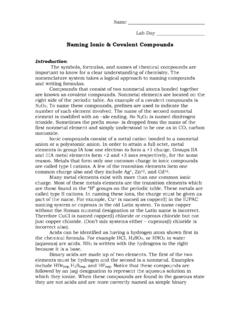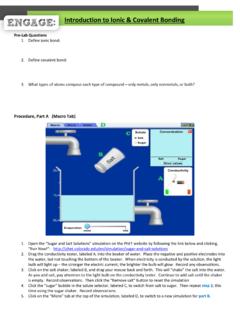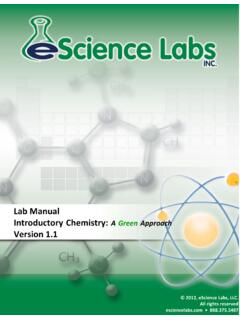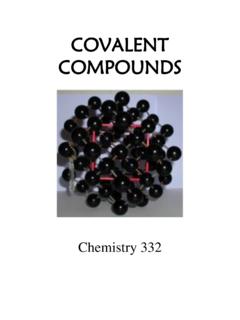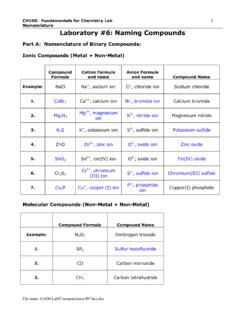Transcription of Ionic and Covalent Substances and Aqueous Reactions
1 Page 1 EXPERIMENT Ionic and Covalent Substances and Aqueous Reactions PURPOSE The goals of this experiment are multiple: 1. To observe the electrical conductivity of various liquids and solutions of Ionic and Covalent compounds using an LED electrical conductivity indicator; 2. To classify these Substances as strong electrolytes, weak electrolytes or nonelectrolytes; 3. To observe the changes in electrical conductivity during double displacement Reactions ; 4. To learn to write general molecular, complete Ionic and net Ionic equations. MATERIALS AND EQUIPMENT 250 mL beaker, LED conductivity indicator, glass evaporating dish, 12-well spot plate, grease pencil, dropper, 175 mL test tubes, #2 stopper, M NH3, M NaCl, NaCl (s), 6M, M and glacial HC2H3O2, M C12H22O11, 95 % C2H5OH, M NaC2H3O2, M NaOH, 6M and M HCl, mossy zinc, CaCO3 (s), phenolphthalein, M CuSO4, M Na3PO4, M Ba(C2H3O2)2, M H2SO4, M Ba(OH)2, 10 mL graduated cylinder.
2 DISCUSSION Ionic Compounds When a metallic element reacts with a non metallic element, the latter becomes negatively charged because one or more electrons are transferred from the metal to the non-metal during the redox reaction. The metal, in turn, becomes positively charged because of the loss of electrons. Such electrically charged atoms are called ions. The positive ion (cation) is attracted to the negative ion (anion) by electrostatic forces forming an Ionic bond. Compounds containing Ionic bonds are called Ionic compounds. In their solid state, the ions are arranged in a crystal lattice, and as such are not free to move. Upon heating, the solids will become fluid. On an atomic level the ions are freed from their positions in the crystal lattice and become mobile. These mobile ions can carry an electrical current, so that molten compounds become good conductors of electricity.
3 Covalent Compounds When two non-metallic elements combine, they do so by mutually sharing a pair (or pairs) of electrons between the atomic nuclei. Such a bond is called a Covalent bond; the compound is called Page 2 a Covalent compound. If the electrons comprising the bond are shared equally, the bond is non-polar. If the electrons comprising the bond are shared unequally by the nuclei, the bond is polar. Covalent compounds do not conduct electricity even when molten because the molten liquid is comprised of neutral particles whose movement cannot carry an electrical current. Thus, these compounds cannot conduct electricity. Electrical Conductivity of Compounds in Aqueous Solution Water is a good solvent for many Ionic and Covalent compounds. Substances that dissolve to form solutions that conduct electricity are called electrolytes.
4 All soluble Ionic compounds are electrolytes. The water molecules that comprise the solvent dissolve the solid by separating the ions in the solid crystal lattice. The water molecules align themselves around each separated ion in the solution (become hydrated) through an ion-dipole interaction. The number of water molecules that align with each ion is unique (for example Zn(H2O)4+2 and Al(H2O)6+3). We shall use the hydrated formula whenever doing so contributes to better understanding the reaction, but in general, for the sake of simplicity, the non-hydrated formula (Zn+2 and Al+3) is used instead. Dissolving sodium chloride in water can thus be written as (the solvent is omitted for simplicity): NaCl (s) Na+ (aq) + Cl (aq). Since the dissolved Ionic solid consists entirely of ions in Aqueous solution, this solution is a good conductor of electricity and will be a strong electrolyte.
5 Ionic compounds that are insoluble in water will not form electrolytes because the solid crystal lattice comprising the Ionic solid stays intact when mixed with water and no ions will form. Solubility of Ionic compounds in water is determined by using solubility rules. Substances with covalently bonded atoms generally have definite neutral molecules as units in any state of matter, and as such will not conduct electricity in Aqueous solution. Substances that dissolve to form nonconducting solutions or do not conduct electricity in pure form are called nonelectrolytes. Solubility in water will be determined by a molecule s polarity. If the electrons comprising the Covalent bonds are equally shared between the two nuclei or if the vector sum of the bond dipoles within a molecule is zero, the molecule is non-polar (for example PCl5 and I2) and will not dissolve in water.
6 If the electrons comprising the Covalent bond are not evenly shared between the nuclei or if the vector sum of the bond dipoles is not equal to zero, the molecule is polar (for example C6H12O6 and CH3OH) and will dissolve in water. However, some polar Covalent compounds (notably acids and bases) will react with water to form ions and so the Aqueous solution will conduct electricity. So, these solutions are electrolytes. The process of forming ions in this way is called ionization. If all of the polar Covalent molecules react in this way, the substance is 100 % ionized (all ions) and as such will behave as a strong electrolyte, just like a soluble salt. The reaction with water can be shown as: HCl (g) + H2O ( ) H3O+ (aq) + Cl (aq) or HCl (g) H+ (aq) + Cl (aq). Water can be included as part of the equation or omitted.
7 Acids and bases that ionize completely (100 % ionized) are called strong acids and strong bases. If only a fraction (usually < 10 %) of the dissolved molecules react with water (ionize), the solution becomes weakly conducting or a weak electrolyte. Acids and bases that behave in this way are called weak acids and weak bases. This can be shown as follows: Page 3 The two arrows pointing in opposite directions show that both reactants and products exist at the same time. Characteristics of strong electrolytes, weak electrolytes and nonelectrolytes are shown the Table 1. Table 1: Characteristics of Electrolyte Solutions * % of an Aqueous sample of HF will exist as ions. The remainder is HF molecules. Most weak electrolytes ionize to a far lesser extent. Double Displacement Reactions These Reactions begin with two compounds. The cation from the first compound is exchanged with the cation from the second compound.
8 This double exchange can be summarized as: AB + CD CB + AD. For example, AgNO3 (aq) + NaCl (aq) AgCl (s) + NaNO3 (aq) Type of Solution Physical Representation Compounds/Ions in Solution Other Examples Strong Electrolyte Cl- Cl Cl- H+(aq) and Cl (aq) NaCl (aq) AgNO3 (aq) K2SO4 (aq) NaOH (aq) HClO4 (aq) Weak Electrolyte HF HF HF HF HF HF HF F HF HF HF HF Mostly HF (aq), A small amount of H+(aq) and F (aq)* HC2H3O2 (aq) NH3 (aq) - can also be written as NH4OH (aq) Nonelectrolyte CH3OH CH3OH CH3OH CH3OH CH3OH CH3OH (aq) C6H12O6 (aq) CH3CH2OH (aq) H+ H+ H+ Cl HF HF CH3OH H+ H+ Page 4 So AB in water can be thought of A+ and B ions, and CD be thought of C+ and D ions.
9 When the reaction occurs, C+ exchanges partners, combining with B , and A+ combines with D . If after the reaction is completed, we form or consume either a precipitate (an Ionic compound that is insoluble in water), or a weakly ionized molecule (such as water, acetic acid, ammonium hydroxide, etc.), or if we produce a gas, we can say that a reaction has occurred. This can be summarized as a reaction occurs in ALL cases whenever there is a change in type of electrolyte for Substances from reactants to products. The reaction will be accompanied by one or more physical changes as evidence of a chemical reaction. This is summarized in Table 2. Table 2: Driving Forces for Double Displacement Reactions If none of the driving forces in Table 2 has occurred, we would then have no reaction. If this situation occurs, when writing a chemical equation, we simply write the reactants, an arrow as we usually would and then write NR for no reaction.
10 For example, NaCl (aq) + KNO3 (aq) NR. Example 1: Gas-Forming Reaction Substances mixed: hydrochloric acid and sodium bicarbonate Observation: Bubbles form The products formed are carbonic acid (H2CO3) and sodium chloride (NaCl). Using the Solubility Table at the end of the procedure, we see that NaCl and NaHCO3 is soluble in water and using the Electrolyte Table (at the end of the experiment), H2CO3 is a weak electrolyte and HCl is a strong electrolyte. Balanced equation: HCl (aq) + NaHCO3 (aq) H2CO3 (aq) + NaCl (aq) (strong elect.) (strong elect.) (weak elect.) (strong elect.) Driving Force Physical Evidence that a Reaction has Occurred Example A gas is formed (Typically CO2, SO2, H2S and NH3) Bubbles Form (Many of the gases listed also have a distinctive odor.)
